CCPCCB5001B: Building Codes and Standards for Medium Rise Buildings
VerifiedAdded on 2022/09/11
|12
|1872
|13
Report
AI Summary
This report comprehensively explores the building codes and standards applicable to medium-rise construction projects, with a focus on fire safety, accessibility, and material specifications. The report begins with an introduction to the relevant codes and standards, including BCA specifications, and proceeds to analyze a case study of a townhouse project. It examines performance requirements, deemed-to-satisfy conditions, and proposed solutions related to accessibility and fire protection systems. The report also delves into the selection of suitable sandwich materials for cold storage applications, considering factors like thermal insulation and fire resistance, as well as the benefits of using sandwich panels in construction. The conclusion highlights the advantages of customization, straightforward installation, and cost-effectiveness offered by these materials. References to relevant literature are also included.

CCPCCB5001B
By Name
Course
Instructor
Institution
Location
Date
By Name
Course
Instructor
Institution
Location
Date
Paraphrase This Document
Need a fresh take? Get an instant paraphrase of this document with our AI Paraphraser
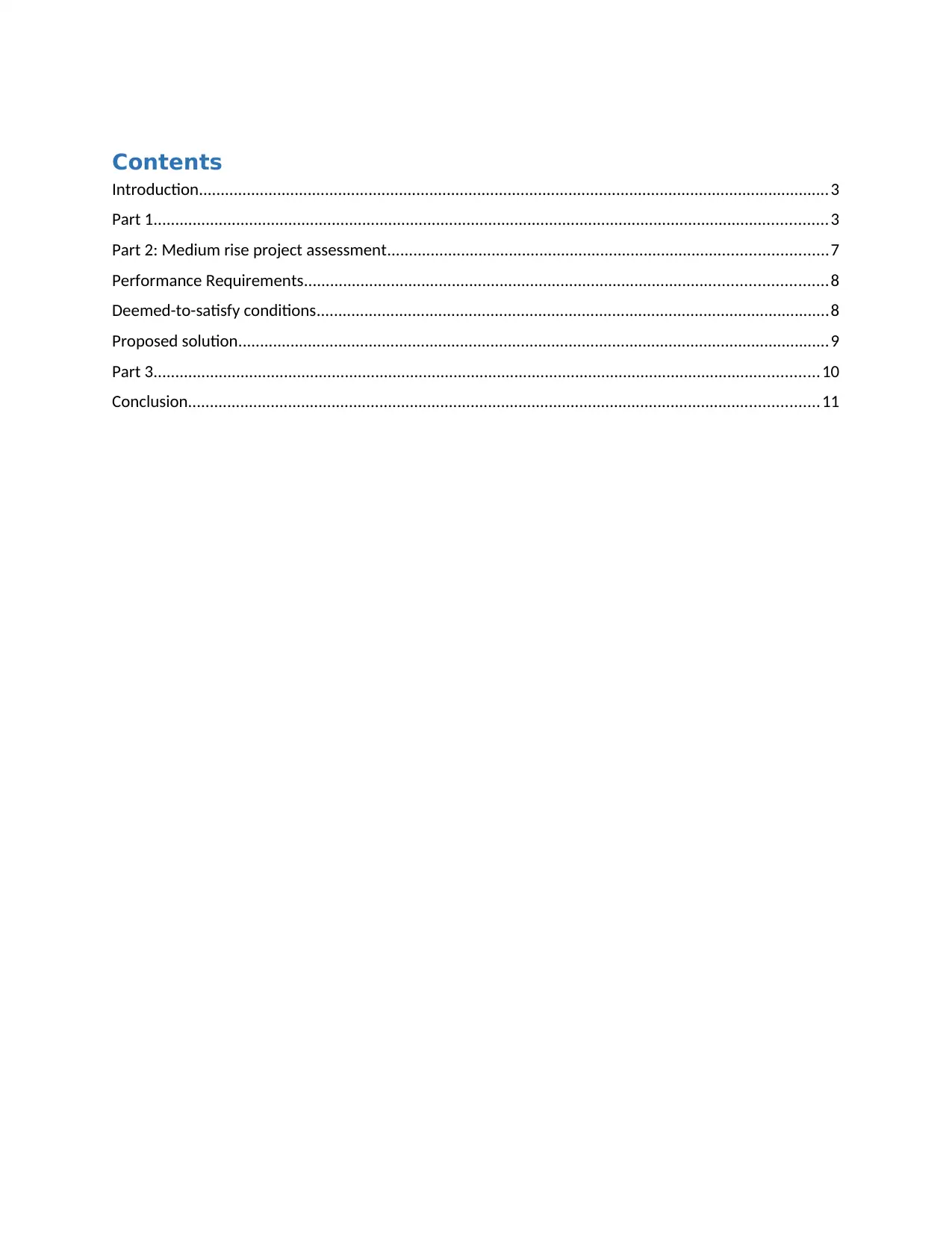
Contents
Introduction.................................................................................................................................................3
Part 1...........................................................................................................................................................3
Part 2: Medium rise project assessment.....................................................................................................7
Performance Requirements........................................................................................................................8
Deemed-to-satisfy conditions......................................................................................................................8
Proposed solution........................................................................................................................................9
Part 3.........................................................................................................................................................10
Conclusion.................................................................................................................................................11
Introduction.................................................................................................................................................3
Part 1...........................................................................................................................................................3
Part 2: Medium rise project assessment.....................................................................................................7
Performance Requirements........................................................................................................................8
Deemed-to-satisfy conditions......................................................................................................................8
Proposed solution........................................................................................................................................9
Part 3.........................................................................................................................................................10
Conclusion.................................................................................................................................................11
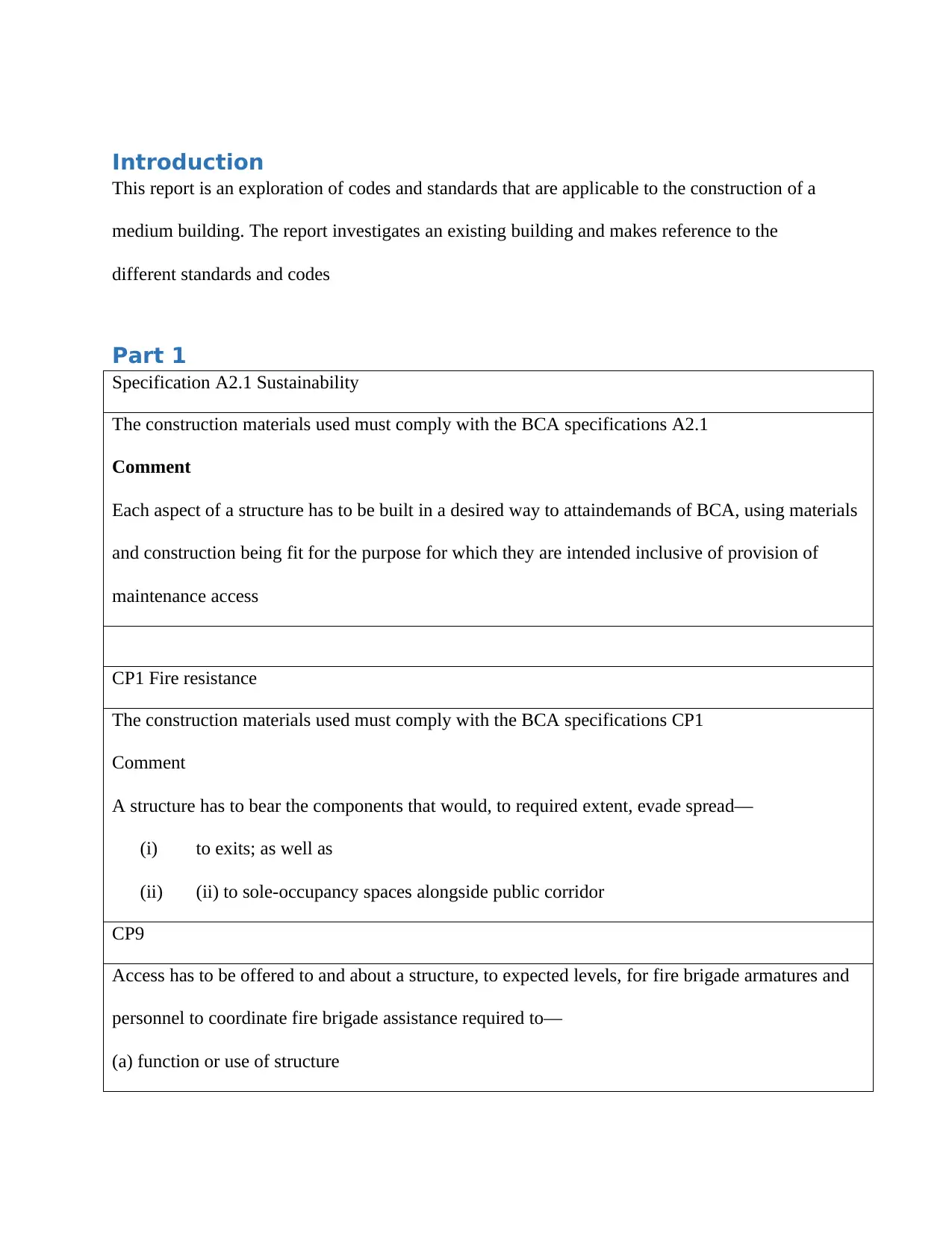
Introduction
This report is an exploration of codes and standards that are applicable to the construction of a
medium building. The report investigates an existing building and makes reference to the
different standards and codes
Part 1
Specification A2.1 Sustainability
The construction materials used must comply with the BCA specifications A2.1
Comment
Each aspect of a structure has to be built in a desired way to attaindemands of BCA, using materials
and construction being fit for the purpose for which they are intended inclusive of provision of
maintenance access
CP1 Fire resistance
The construction materials used must comply with the BCA specifications CP1
Comment
A structure has to bear the components that would, to required extent, evade spread—
(i) to exits; as well as
(ii) (ii) to sole-occupancy spaces alongside public corridor
CP9
Access has to be offered to and about a structure, to expected levels, for fire brigade armatures and
personnel to coordinate fire brigade assistance required to—
(a) function or use of structure
This report is an exploration of codes and standards that are applicable to the construction of a
medium building. The report investigates an existing building and makes reference to the
different standards and codes
Part 1
Specification A2.1 Sustainability
The construction materials used must comply with the BCA specifications A2.1
Comment
Each aspect of a structure has to be built in a desired way to attaindemands of BCA, using materials
and construction being fit for the purpose for which they are intended inclusive of provision of
maintenance access
CP1 Fire resistance
The construction materials used must comply with the BCA specifications CP1
Comment
A structure has to bear the components that would, to required extent, evade spread—
(i) to exits; as well as
(ii) (ii) to sole-occupancy spaces alongside public corridor
CP9
Access has to be offered to and about a structure, to expected levels, for fire brigade armatures and
personnel to coordinate fire brigade assistance required to—
(a) function or use of structure
⊘ This is a preview!⊘
Do you want full access?
Subscribe today to unlock all pages.

Trusted by 1+ million students worldwide
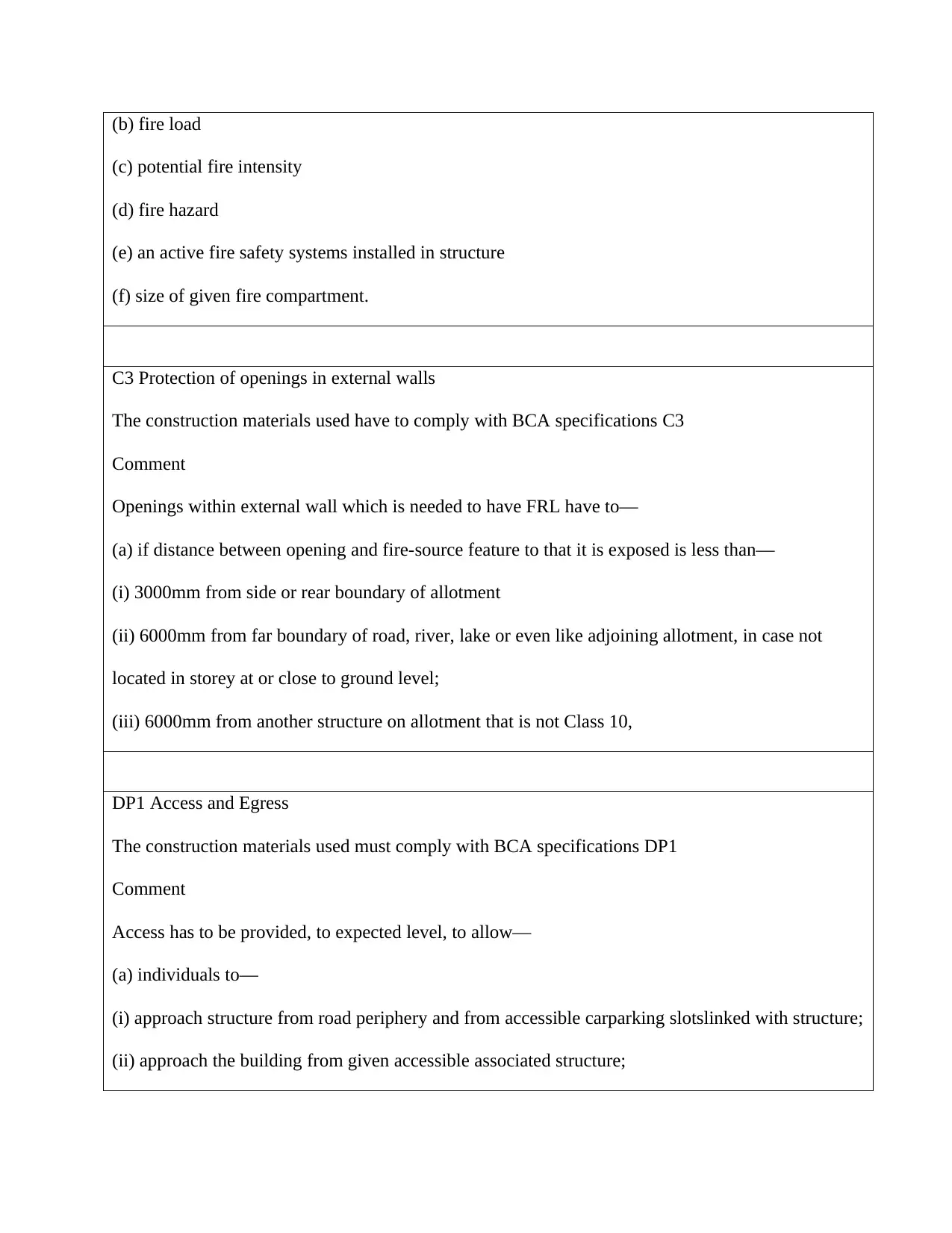
(b) fire load
(c) potential fire intensity
(d) fire hazard
(e) an active fire safety systems installed in structure
(f) size of given fire compartment.
C3 Protection of openings in external walls
The construction materials used have to comply with BCA specifications C3
Comment
Openings within external wall which is needed to have FRL have to—
(a) if distance between opening and fire-source feature to that it is exposed is less than—
(i) 3000mm from side or rear boundary of allotment
(ii) 6000mm from far boundary of road, river, lake or even like adjoining allotment, in case not
located in storey at or close to ground level;
(iii) 6000mm from another structure on allotment that is not Class 10,
DP1 Access and Egress
The construction materials used must comply with BCA specifications DP1
Comment
Access has to be provided, to expected level, to allow—
(a) individuals to—
(i) approach structure from road periphery and from accessible carparking slotslinked with structure;
(ii) approach the building from given accessible associated structure;
(c) potential fire intensity
(d) fire hazard
(e) an active fire safety systems installed in structure
(f) size of given fire compartment.
C3 Protection of openings in external walls
The construction materials used have to comply with BCA specifications C3
Comment
Openings within external wall which is needed to have FRL have to—
(a) if distance between opening and fire-source feature to that it is exposed is less than—
(i) 3000mm from side or rear boundary of allotment
(ii) 6000mm from far boundary of road, river, lake or even like adjoining allotment, in case not
located in storey at or close to ground level;
(iii) 6000mm from another structure on allotment that is not Class 10,
DP1 Access and Egress
The construction materials used must comply with BCA specifications DP1
Comment
Access has to be provided, to expected level, to allow—
(a) individuals to—
(i) approach structure from road periphery and from accessible carparking slotslinked with structure;
(ii) approach the building from given accessible associated structure;
Paraphrase This Document
Need a fresh take? Get an instant paraphrase of this document with our AI Paraphraser
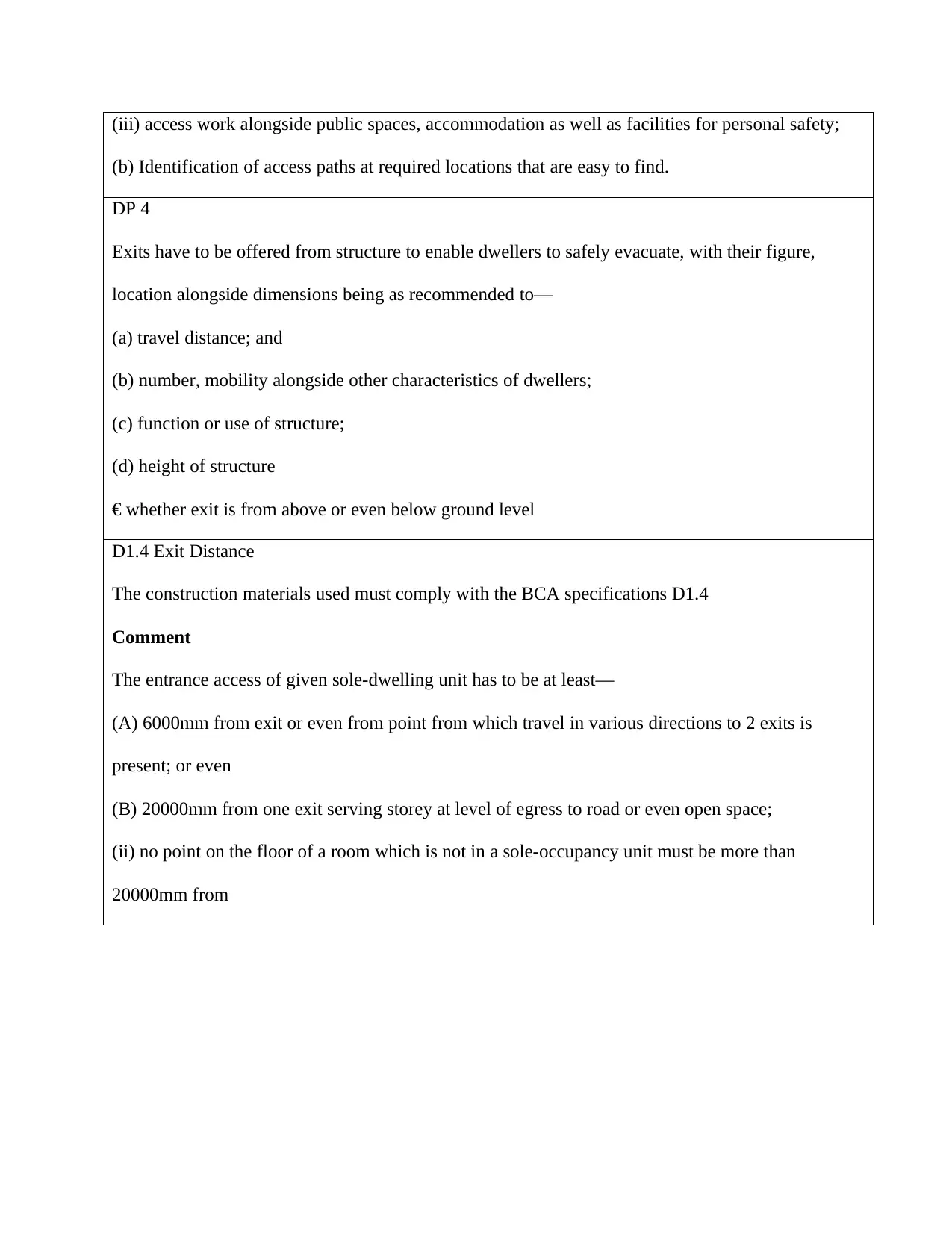
(iii) access work alongside public spaces, accommodation as well as facilities for personal safety;
(b) Identification of access paths at required locations that are easy to find.
DP 4
Exits have to be offered from structure to enable dwellers to safely evacuate, with their figure,
location alongside dimensions being as recommended to—
(a) travel distance; and
(b) number, mobility alongside other characteristics of dwellers;
(c) function or use of structure;
(d) height of structure
€ whether exit is from above or even below ground level
D1.4 Exit Distance
The construction materials used must comply with the BCA specifications D1.4
Comment
The entrance access of given sole-dwelling unit has to be at least—
(A) 6000mm from exit or even from point from which travel in various directions to 2 exits is
present; or even
(B) 20000mm from one exit serving storey at level of egress to road or even open space;
(ii) no point on the floor of a room which is not in a sole-occupancy unit must be more than
20000mm from
(b) Identification of access paths at required locations that are easy to find.
DP 4
Exits have to be offered from structure to enable dwellers to safely evacuate, with their figure,
location alongside dimensions being as recommended to—
(a) travel distance; and
(b) number, mobility alongside other characteristics of dwellers;
(c) function or use of structure;
(d) height of structure
€ whether exit is from above or even below ground level
D1.4 Exit Distance
The construction materials used must comply with the BCA specifications D1.4
Comment
The entrance access of given sole-dwelling unit has to be at least—
(A) 6000mm from exit or even from point from which travel in various directions to 2 exits is
present; or even
(B) 20000mm from one exit serving storey at level of egress to road or even open space;
(ii) no point on the floor of a room which is not in a sole-occupancy unit must be more than
20000mm from
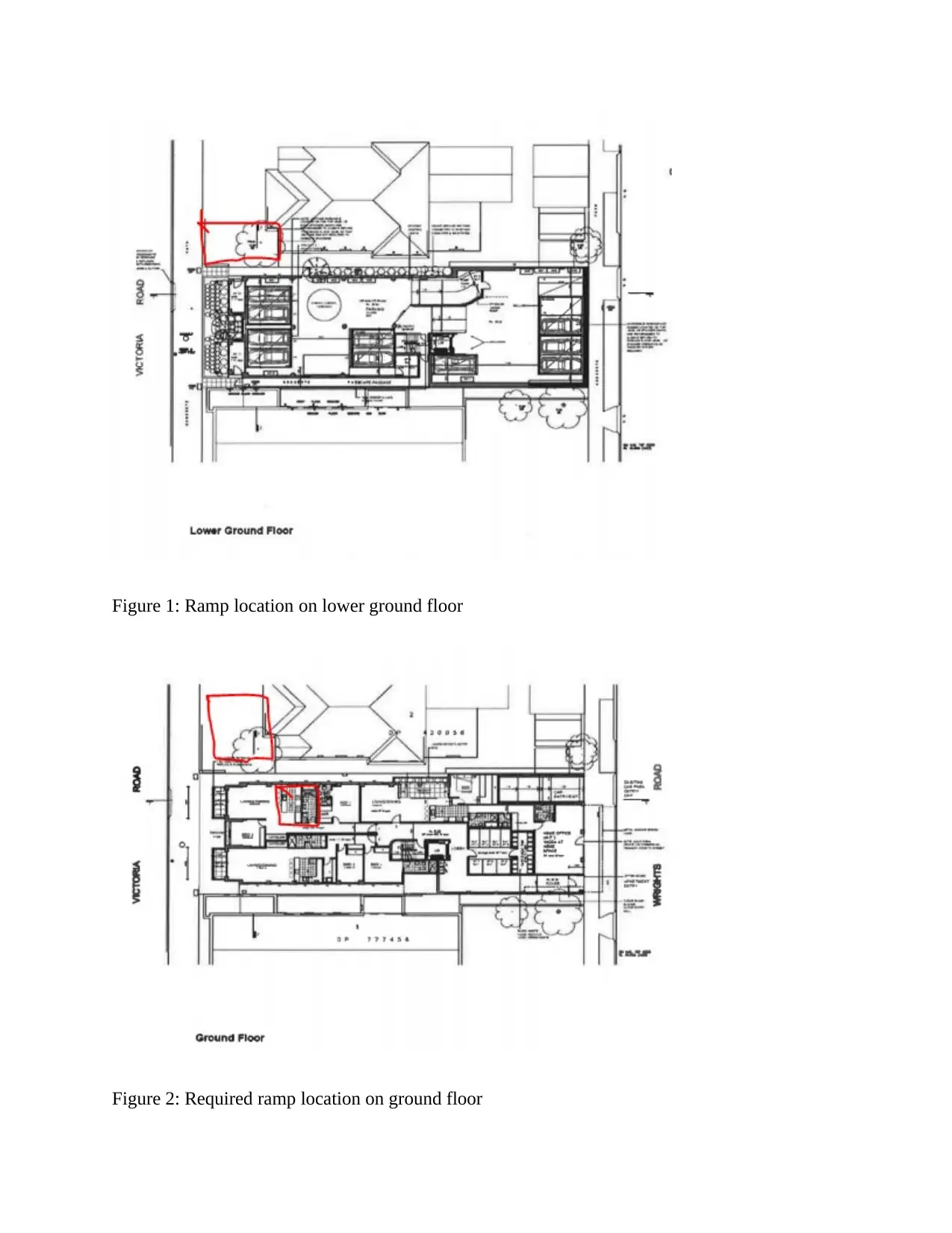
Figure 1: Ramp location on lower ground floor
Figure 2: Required ramp location on ground floor
Figure 2: Required ramp location on ground floor
⊘ This is a preview!⊘
Do you want full access?
Subscribe today to unlock all pages.

Trusted by 1+ million students worldwide
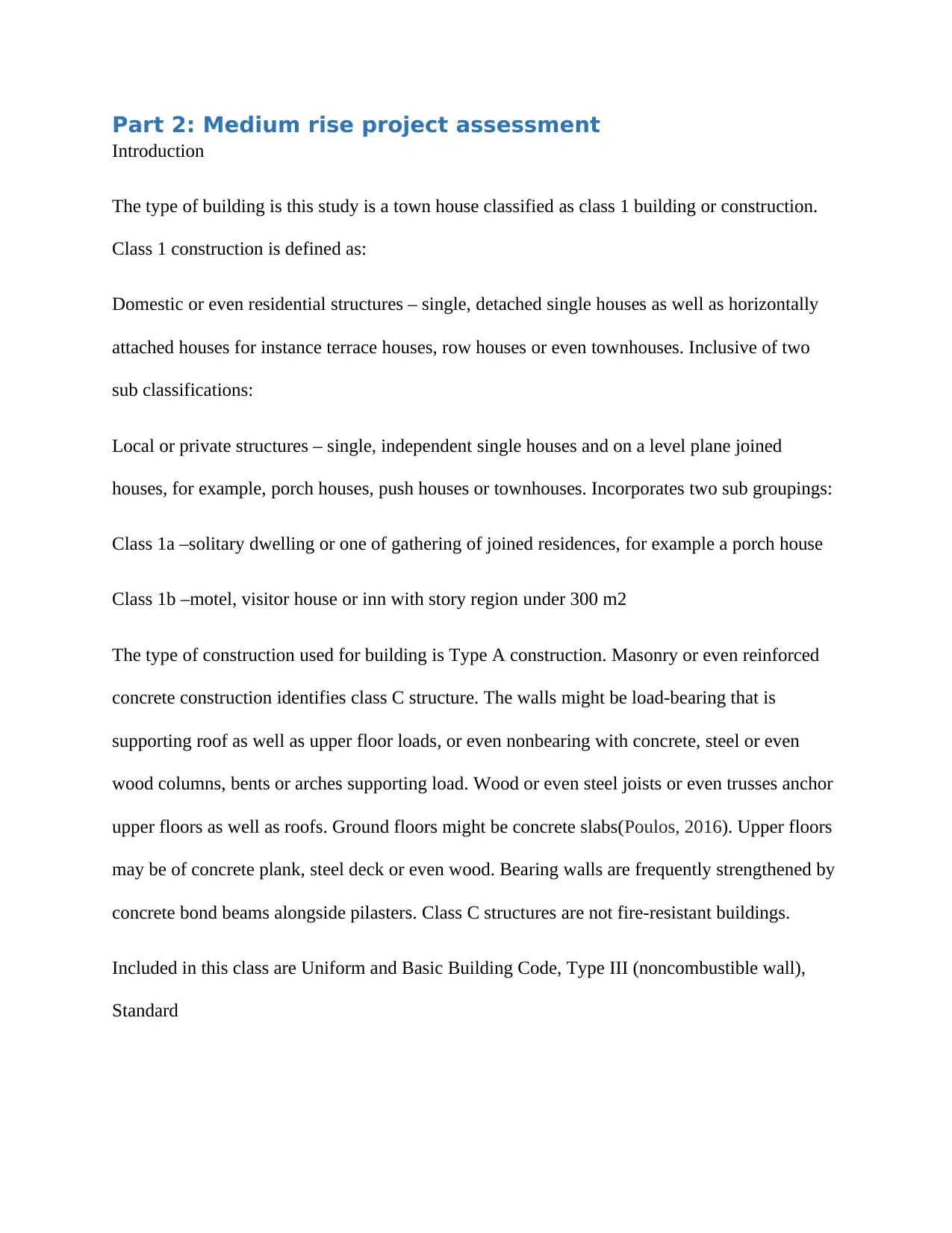
Part 2: Medium rise project assessment
Introduction
The type of building is this study is a town house classified as class 1 building or construction.
Class 1 construction is defined as:
Domestic or even residential structures – single, detached single houses as well as horizontally
attached houses for instance terrace houses, row houses or even townhouses. Inclusive of two
sub classifications:
Local or private structures – single, independent single houses and on a level plane joined
houses, for example, porch houses, push houses or townhouses. Incorporates two sub groupings:
Class 1a –solitary dwelling or one of gathering of joined residences, for example a porch house
Class 1b –motel, visitor house or inn with story region under 300 m2
The type of construction used for building is Type A construction. Masonry or even reinforced
concrete construction identifies class C structure. The walls might be load‐bearing that is
supporting roof as well as upper floor loads, or even nonbearing with concrete, steel or even
wood columns, bents or arches supporting load. Wood or even steel joists or even trusses anchor
upper floors as well as roofs. Ground floors might be concrete slabs(Poulos, 2016). Upper floors
may be of concrete plank, steel deck or even wood. Bearing walls are frequently strengthened by
concrete bond beams alongside pilasters. Class C structures are not fire‐resistant buildings.
Included in this class are Uniform and Basic Building Code, Type III (noncombustible wall),
Standard
Introduction
The type of building is this study is a town house classified as class 1 building or construction.
Class 1 construction is defined as:
Domestic or even residential structures – single, detached single houses as well as horizontally
attached houses for instance terrace houses, row houses or even townhouses. Inclusive of two
sub classifications:
Local or private structures – single, independent single houses and on a level plane joined
houses, for example, porch houses, push houses or townhouses. Incorporates two sub groupings:
Class 1a –solitary dwelling or one of gathering of joined residences, for example a porch house
Class 1b –motel, visitor house or inn with story region under 300 m2
The type of construction used for building is Type A construction. Masonry or even reinforced
concrete construction identifies class C structure. The walls might be load‐bearing that is
supporting roof as well as upper floor loads, or even nonbearing with concrete, steel or even
wood columns, bents or arches supporting load. Wood or even steel joists or even trusses anchor
upper floors as well as roofs. Ground floors might be concrete slabs(Poulos, 2016). Upper floors
may be of concrete plank, steel deck or even wood. Bearing walls are frequently strengthened by
concrete bond beams alongside pilasters. Class C structures are not fire‐resistant buildings.
Included in this class are Uniform and Basic Building Code, Type III (noncombustible wall),
Standard
Paraphrase This Document
Need a fresh take? Get an instant paraphrase of this document with our AI Paraphraser
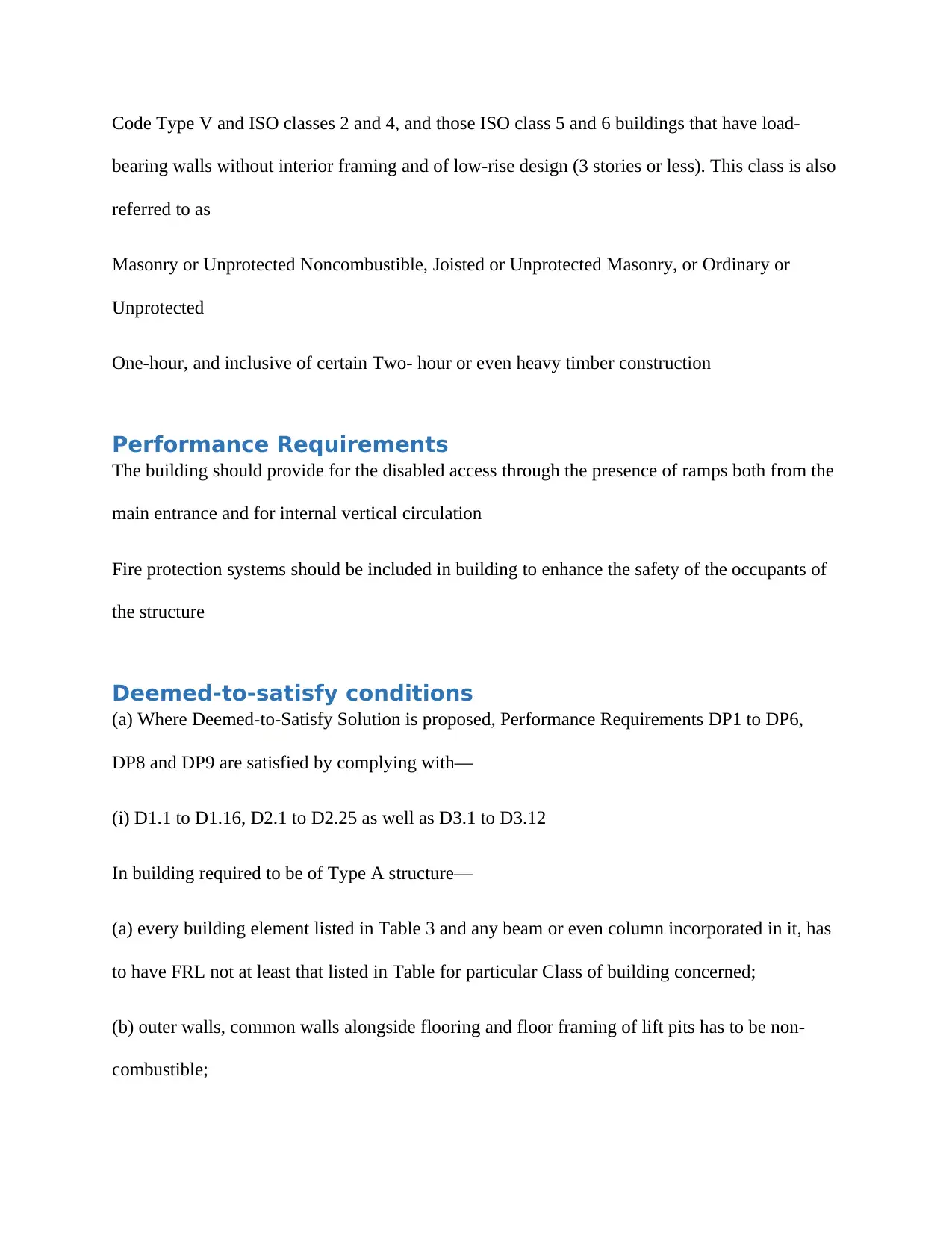
Code Type V and ISO classes 2 and 4, and those ISO class 5 and 6 buildings that have load‐
bearing walls without interior framing and of low‐rise design (3 stories or less). This class is also
referred to as
Masonry or Unprotected Noncombustible, Joisted or Unprotected Masonry, or Ordinary or
Unprotected
One‐hour, and inclusive of certain Two‐ hour or even heavy timber construction
Performance Requirements
The building should provide for the disabled access through the presence of ramps both from the
main entrance and for internal vertical circulation
Fire protection systems should be included in building to enhance the safety of the occupants of
the structure
Deemed-to-satisfy conditions
(a) Where Deemed-to-Satisfy Solution is proposed, Performance Requirements DP1 to DP6,
DP8 and DP9 are satisfied by complying with—
(i) D1.1 to D1.16, D2.1 to D2.25 as well as D3.1 to D3.12
In building required to be of Type A structure—
(a) every building element listed in Table 3 and any beam or even column incorporated in it, has
to have FRL not at least that listed in Table for particular Class of building concerned;
(b) outer walls, common walls alongside flooring and floor framing of lift pits has to be non-
combustible;
bearing walls without interior framing and of low‐rise design (3 stories or less). This class is also
referred to as
Masonry or Unprotected Noncombustible, Joisted or Unprotected Masonry, or Ordinary or
Unprotected
One‐hour, and inclusive of certain Two‐ hour or even heavy timber construction
Performance Requirements
The building should provide for the disabled access through the presence of ramps both from the
main entrance and for internal vertical circulation
Fire protection systems should be included in building to enhance the safety of the occupants of
the structure
Deemed-to-satisfy conditions
(a) Where Deemed-to-Satisfy Solution is proposed, Performance Requirements DP1 to DP6,
DP8 and DP9 are satisfied by complying with—
(i) D1.1 to D1.16, D2.1 to D2.25 as well as D3.1 to D3.12
In building required to be of Type A structure—
(a) every building element listed in Table 3 and any beam or even column incorporated in it, has
to have FRL not at least that listed in Table for particular Class of building concerned;
(b) outer walls, common walls alongside flooring and floor framing of lift pits has to be non-
combustible;
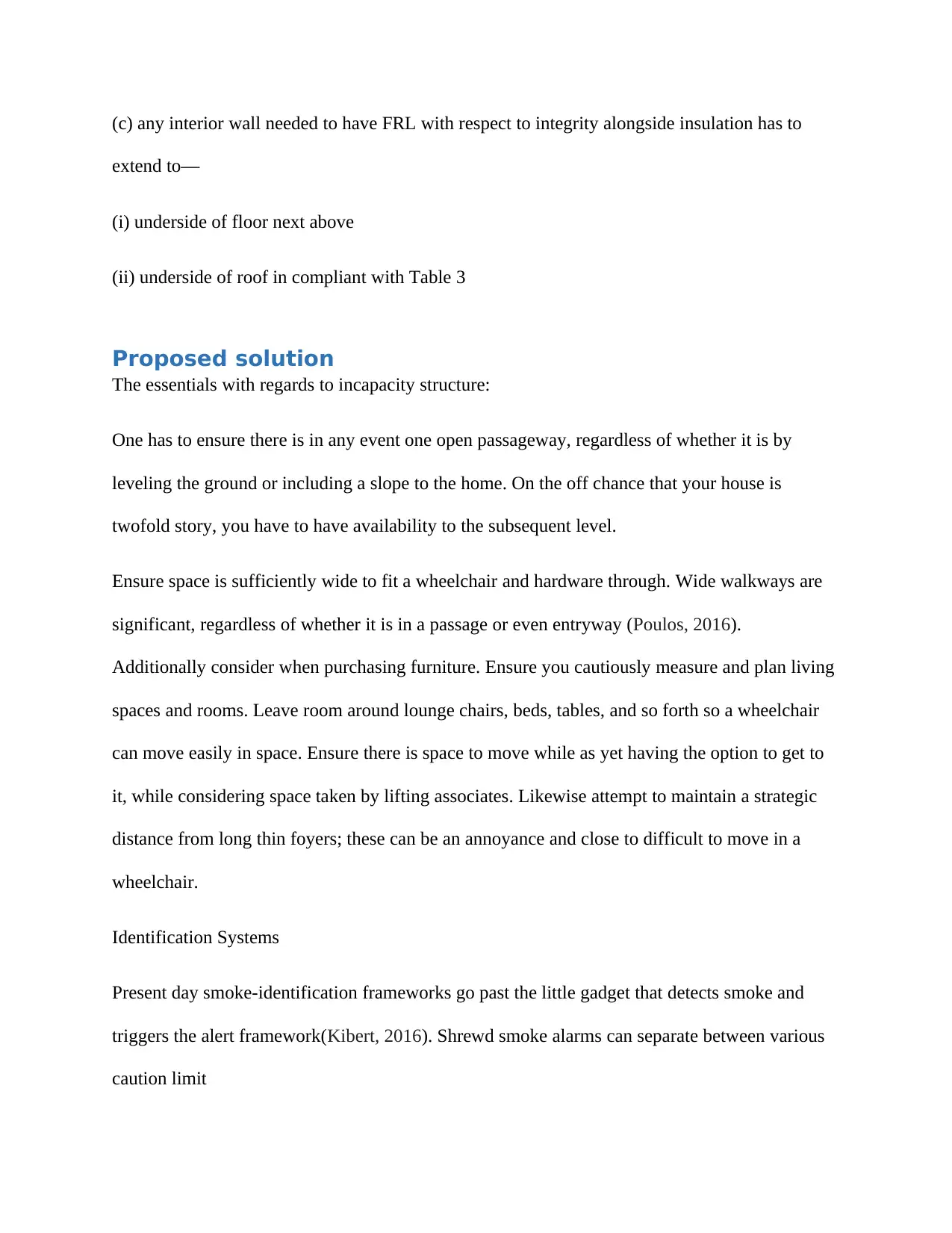
(c) any interior wall needed to have FRL with respect to integrity alongside insulation has to
extend to—
(i) underside of floor next above
(ii) underside of roof in compliant with Table 3
Proposed solution
The essentials with regards to incapacity structure:
One has to ensure there is in any event one open passageway, regardless of whether it is by
leveling the ground or including a slope to the home. On the off chance that your house is
twofold story, you have to have availability to the subsequent level.
Ensure space is sufficiently wide to fit a wheelchair and hardware through. Wide walkways are
significant, regardless of whether it is in a passage or even entryway (Poulos, 2016).
Additionally consider when purchasing furniture. Ensure you cautiously measure and plan living
spaces and rooms. Leave room around lounge chairs, beds, tables, and so forth so a wheelchair
can move easily in space. Ensure there is space to move while as yet having the option to get to
it, while considering space taken by lifting associates. Likewise attempt to maintain a strategic
distance from long thin foyers; these can be an annoyance and close to difficult to move in a
wheelchair.
Identification Systems
Present day smoke-identification frameworks go past the little gadget that detects smoke and
triggers the alert framework(Kibert, 2016). Shrewd smoke alarms can separate between various
caution limit
extend to—
(i) underside of floor next above
(ii) underside of roof in compliant with Table 3
Proposed solution
The essentials with regards to incapacity structure:
One has to ensure there is in any event one open passageway, regardless of whether it is by
leveling the ground or including a slope to the home. On the off chance that your house is
twofold story, you have to have availability to the subsequent level.
Ensure space is sufficiently wide to fit a wheelchair and hardware through. Wide walkways are
significant, regardless of whether it is in a passage or even entryway (Poulos, 2016).
Additionally consider when purchasing furniture. Ensure you cautiously measure and plan living
spaces and rooms. Leave room around lounge chairs, beds, tables, and so forth so a wheelchair
can move easily in space. Ensure there is space to move while as yet having the option to get to
it, while considering space taken by lifting associates. Likewise attempt to maintain a strategic
distance from long thin foyers; these can be an annoyance and close to difficult to move in a
wheelchair.
Identification Systems
Present day smoke-identification frameworks go past the little gadget that detects smoke and
triggers the alert framework(Kibert, 2016). Shrewd smoke alarms can separate between various
caution limit
⊘ This is a preview!⊘
Do you want full access?
Subscribe today to unlock all pages.

Trusted by 1+ million students worldwide
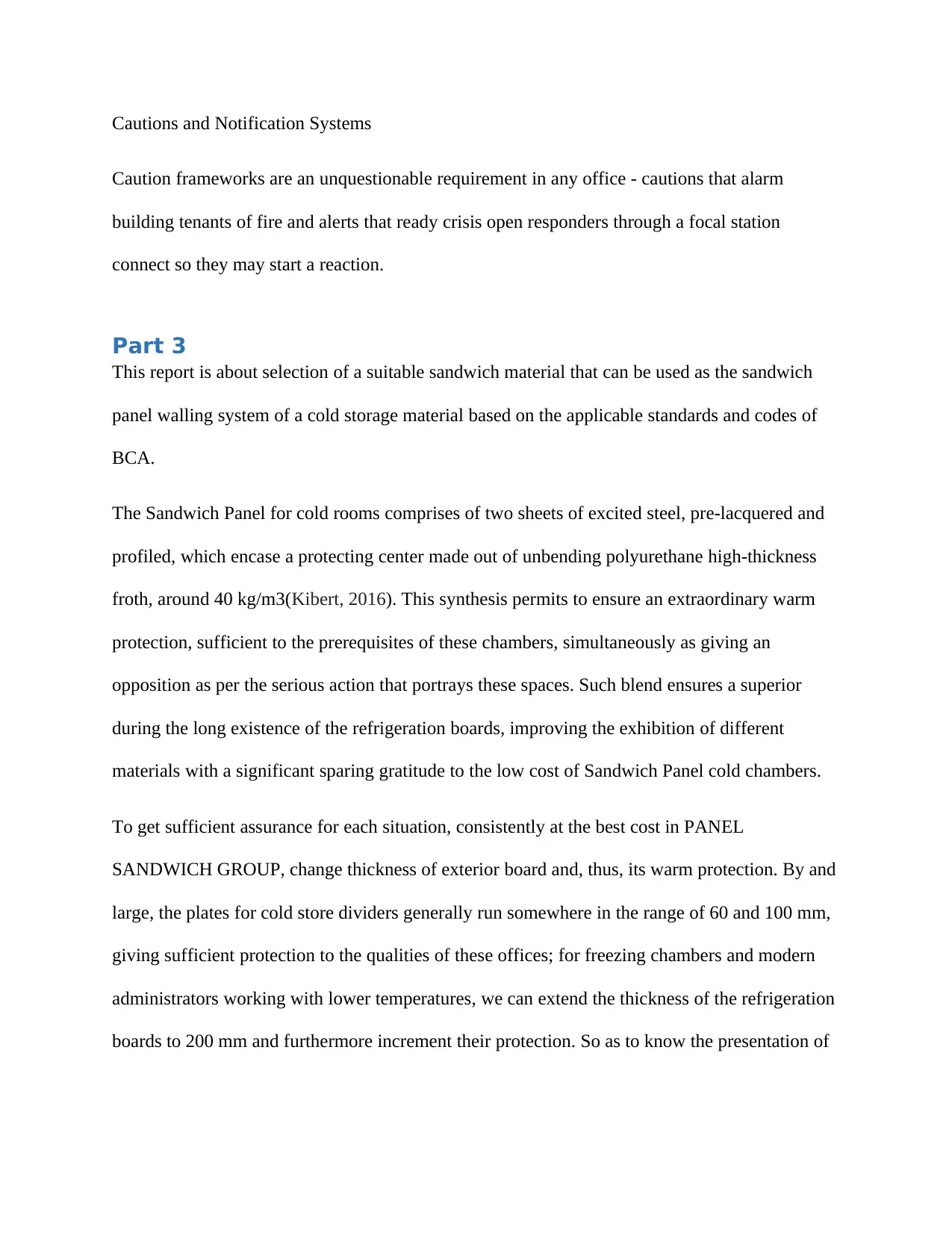
Cautions and Notification Systems
Caution frameworks are an unquestionable requirement in any office - cautions that alarm
building tenants of fire and alerts that ready crisis open responders through a focal station
connect so they may start a reaction.
Part 3
This report is about selection of a suitable sandwich material that can be used as the sandwich
panel walling system of a cold storage material based on the applicable standards and codes of
BCA.
The Sandwich Panel for cold rooms comprises of two sheets of excited steel, pre-lacquered and
profiled, which encase a protecting center made out of unbending polyurethane high-thickness
froth, around 40 kg/m3(Kibert, 2016). This synthesis permits to ensure an extraordinary warm
protection, sufficient to the prerequisites of these chambers, simultaneously as giving an
opposition as per the serious action that portrays these spaces. Such blend ensures a superior
during the long existence of the refrigeration boards, improving the exhibition of different
materials with a significant sparing gratitude to the low cost of Sandwich Panel cold chambers.
To get sufficient assurance for each situation, consistently at the best cost in PANEL
SANDWICH GROUP, change thickness of exterior board and, thus, its warm protection. By and
large, the plates for cold store dividers generally run somewhere in the range of 60 and 100 mm,
giving sufficient protection to the qualities of these offices; for freezing chambers and modern
administrators working with lower temperatures, we can extend the thickness of the refrigeration
boards to 200 mm and furthermore increment their protection. So as to know the presentation of
Caution frameworks are an unquestionable requirement in any office - cautions that alarm
building tenants of fire and alerts that ready crisis open responders through a focal station
connect so they may start a reaction.
Part 3
This report is about selection of a suitable sandwich material that can be used as the sandwich
panel walling system of a cold storage material based on the applicable standards and codes of
BCA.
The Sandwich Panel for cold rooms comprises of two sheets of excited steel, pre-lacquered and
profiled, which encase a protecting center made out of unbending polyurethane high-thickness
froth, around 40 kg/m3(Kibert, 2016). This synthesis permits to ensure an extraordinary warm
protection, sufficient to the prerequisites of these chambers, simultaneously as giving an
opposition as per the serious action that portrays these spaces. Such blend ensures a superior
during the long existence of the refrigeration boards, improving the exhibition of different
materials with a significant sparing gratitude to the low cost of Sandwich Panel cold chambers.
To get sufficient assurance for each situation, consistently at the best cost in PANEL
SANDWICH GROUP, change thickness of exterior board and, thus, its warm protection. By and
large, the plates for cold store dividers generally run somewhere in the range of 60 and 100 mm,
giving sufficient protection to the qualities of these offices; for freezing chambers and modern
administrators working with lower temperatures, we can extend the thickness of the refrigeration
boards to 200 mm and furthermore increment their protection. So as to know the presentation of
Paraphrase This Document
Need a fresh take? Get an instant paraphrase of this document with our AI Paraphraser
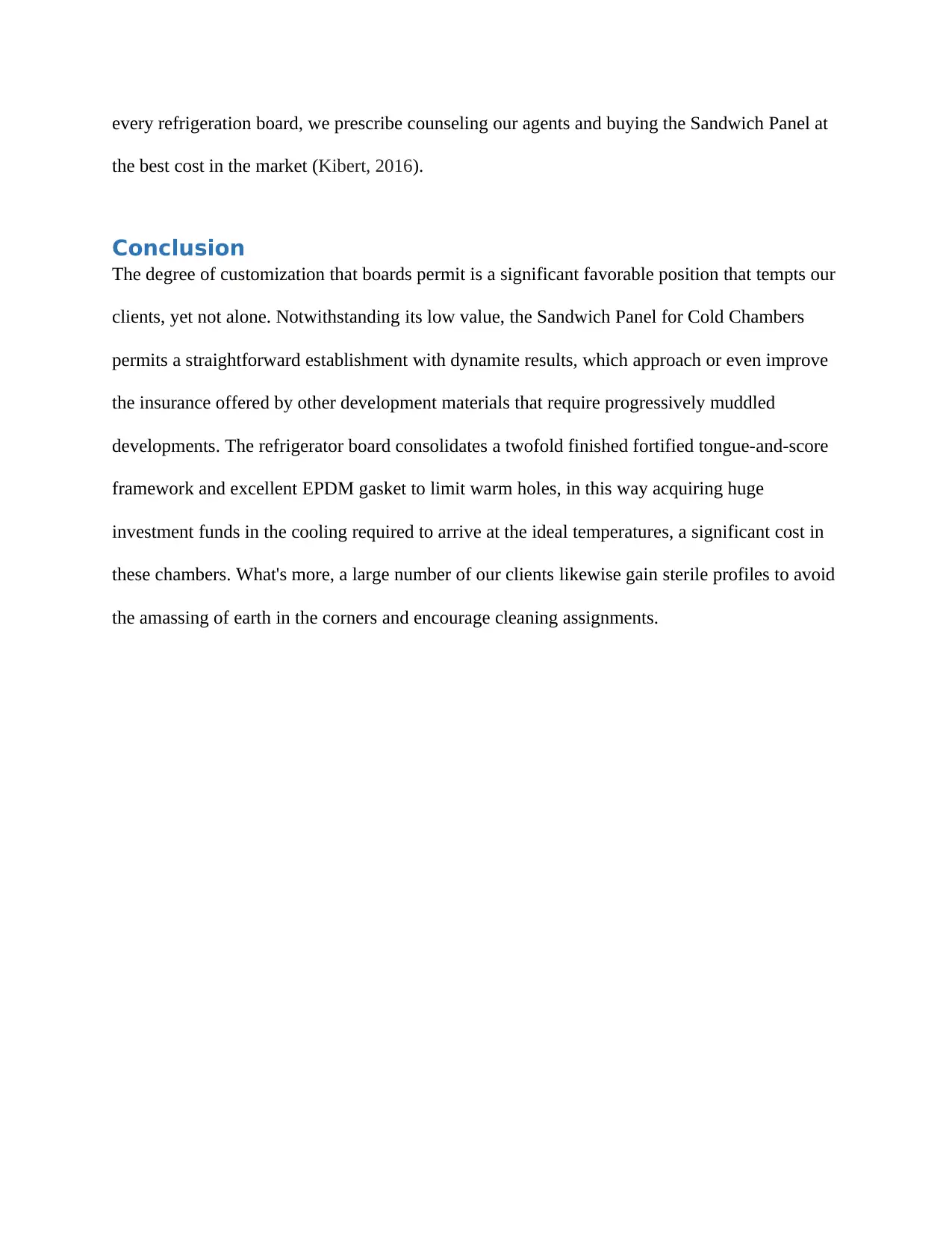
every refrigeration board, we prescribe counseling our agents and buying the Sandwich Panel at
the best cost in the market (Kibert, 2016).
Conclusion
The degree of customization that boards permit is a significant favorable position that tempts our
clients, yet not alone. Notwithstanding its low value, the Sandwich Panel for Cold Chambers
permits a straightforward establishment with dynamite results, which approach or even improve
the insurance offered by other development materials that require progressively muddled
developments. The refrigerator board consolidates a twofold finished fortified tongue-and-score
framework and excellent EPDM gasket to limit warm holes, in this way acquiring huge
investment funds in the cooling required to arrive at the ideal temperatures, a significant cost in
these chambers. What's more, a large number of our clients likewise gain sterile profiles to avoid
the amassing of earth in the corners and encourage cleaning assignments.
the best cost in the market (Kibert, 2016).
Conclusion
The degree of customization that boards permit is a significant favorable position that tempts our
clients, yet not alone. Notwithstanding its low value, the Sandwich Panel for Cold Chambers
permits a straightforward establishment with dynamite results, which approach or even improve
the insurance offered by other development materials that require progressively muddled
developments. The refrigerator board consolidates a twofold finished fortified tongue-and-score
framework and excellent EPDM gasket to limit warm holes, in this way acquiring huge
investment funds in the cooling required to arrive at the ideal temperatures, a significant cost in
these chambers. What's more, a large number of our clients likewise gain sterile profiles to avoid
the amassing of earth in the corners and encourage cleaning assignments.
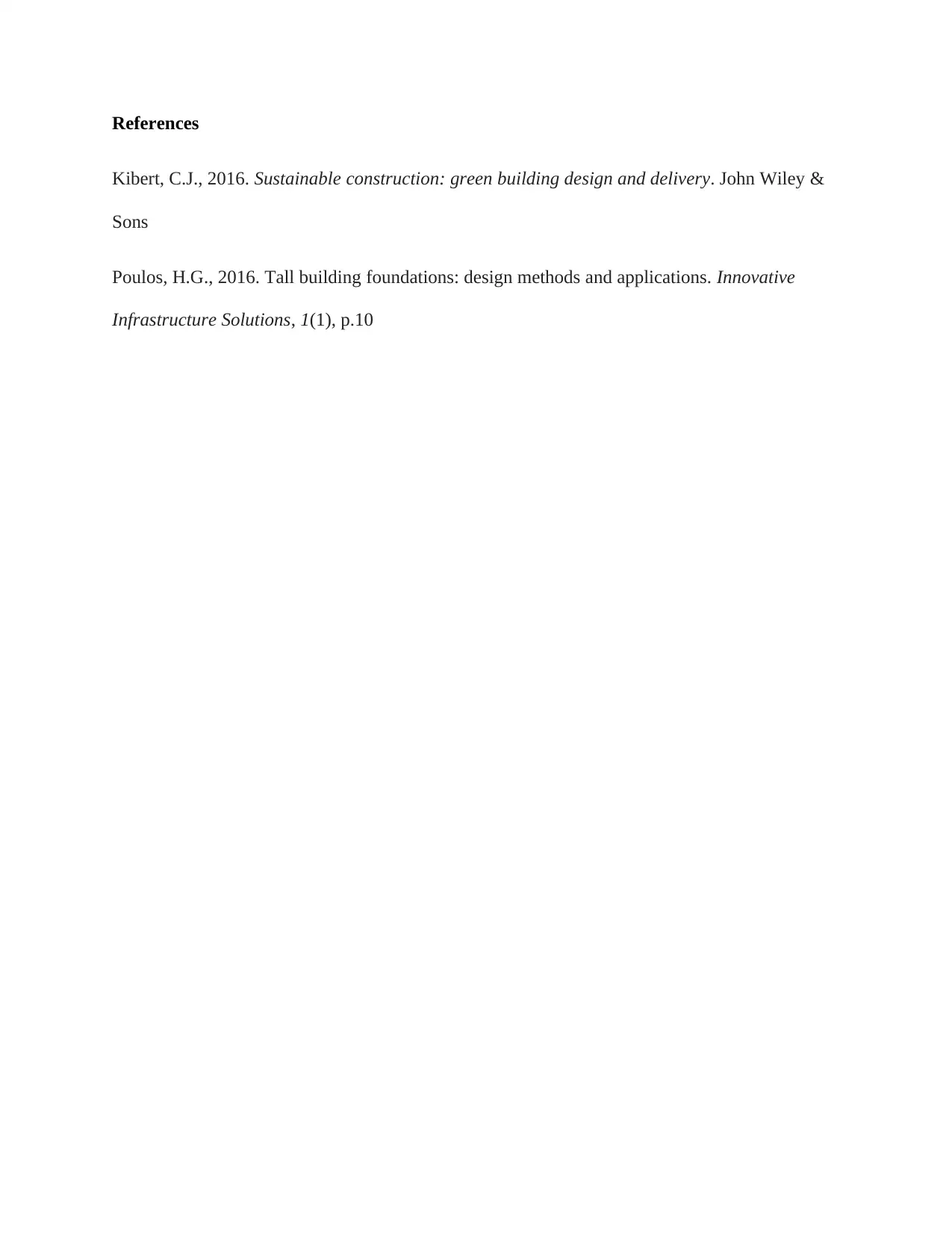
References
Kibert, C.J., 2016. Sustainable construction: green building design and delivery. John Wiley &
Sons
Poulos, H.G., 2016. Tall building foundations: design methods and applications. Innovative
Infrastructure Solutions, 1(1), p.10
Kibert, C.J., 2016. Sustainable construction: green building design and delivery. John Wiley &
Sons
Poulos, H.G., 2016. Tall building foundations: design methods and applications. Innovative
Infrastructure Solutions, 1(1), p.10
⊘ This is a preview!⊘
Do you want full access?
Subscribe today to unlock all pages.

Trusted by 1+ million students worldwide
1 out of 12
Related Documents
Your All-in-One AI-Powered Toolkit for Academic Success.
+13062052269
info@desklib.com
Available 24*7 on WhatsApp / Email
![[object Object]](/_next/static/media/star-bottom.7253800d.svg)
Unlock your academic potential
Copyright © 2020–2025 A2Z Services. All Rights Reserved. Developed and managed by ZUCOL.





